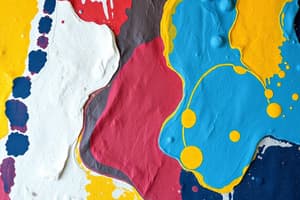Podcast
Questions and Answers
What does the term 'prehistoric' imply?
What does the term 'prehistoric' imply?
- An era when humans domesticated animals.
- A period defined by the development of written language.
- The age of advanced technological inventions.
- A time frame before the use of paper and writing. (correct)
What materials did prehistoric humans use for their cave drawings?
What materials did prehistoric humans use for their cave drawings?
- Paints made from chemical compounds.
- Wood, stone, and mud. (correct)
- Colored dyes from plants and minerals.
- Charcoal, iron oxide, and animal fat.
During which period did humans produce their earliest works of art?
During which period did humans produce their earliest works of art?
- Middle Paleolithic Period.
- Mesolithic period.
- Neolithic period.
- Upper Paleolithic Aurignacian period. (correct)
What was a primary motivation for prehistoric humans to create art?
What was a primary motivation for prehistoric humans to create art?
What purpose did the magic rituals serve for prehistoric humans?
What purpose did the magic rituals serve for prehistoric humans?
What do prehistoric rock paintings primarily provide insight into?
What do prehistoric rock paintings primarily provide insight into?
What 'big beasts' challenge did prehistoric humans face?
What 'big beasts' challenge did prehistoric humans face?
Where did prehistoric humans typically live 25,000 years ago?
Where did prehistoric humans typically live 25,000 years ago?
What aspect of prehistoric life does the term 'prehistoric rock paintings' primarily highlight?
What aspect of prehistoric life does the term 'prehistoric rock paintings' primarily highlight?
What was one psychological reason prehistoric humans engaged in art creation?
What was one psychological reason prehistoric humans engaged in art creation?
Which materials were likely NOT used by prehistoric humans in their cave art?
Which materials were likely NOT used by prehistoric humans in their cave art?
The Upper Paleolithic period is significant for what reason in the context of prehistoric art?
The Upper Paleolithic period is significant for what reason in the context of prehistoric art?
What environmental feature was most prominent in the world about 25,000 years ago?
What environmental feature was most prominent in the world about 25,000 years ago?
What were early cave art depictions likely intended to represent?
What were early cave art depictions likely intended to represent?
In what ways did prehistoric humans primarily express their desire for communication?
In what ways did prehistoric humans primarily express their desire for communication?
What role did the concept of magic play in the art-creating activities of prehistoric humans?
What role did the concept of magic play in the art-creating activities of prehistoric humans?
Flashcards are hidden until you start studying
Study Notes
Prehistoric Era
- Refers to the time before the invention of paper and written language.
- Early communication manifested through rock paintings and wall scribbles.
Rock Paintings
- Serve as important historical artifacts providing insights into prehistoric lifestyles.
- Offer details about tools, pottery, and the daily lives of early humans.
Lifestyle of Prehistoric Humans
- Approximately 25,000 years ago, the Earth was densely covered with jungles.
- Ancestors resided in caves, valleys, near streams, and close to rivers or pools.
- Diet consisted of various grasses, fruits, vegetables, and hunting of large animals.
Early Art and Its Purpose
- Questions arise regarding the motivation behind the creation of early artworks.
- Art created as a form of magic or ritual to overcome daily challenges and appease nature.
- Drawings on cave walls served dual purposes: expressing human creativity and fulfilling spiritual needs.
Psyche and Rituals
- Prehistoric man believed in performing rituals to gain strength to hunt and survive.
- Artistic expression was intertwined with a desire for safety from natural calamities and beasts.
Historical Context
- The first known artistic creations occurred during the Upper Paleolithic period, specifically the Aurignacian culture (circa 45,000 B.C. to 35,000 B.C.).
- Early images reflect the blend of art with spirituality and survival instincts.
Prehistoric Era
- Refers to the time before the invention of paper and written language.
- Early communication manifested through rock paintings and wall scribbles.
Rock Paintings
- Serve as important historical artifacts providing insights into prehistoric lifestyles.
- Offer details about tools, pottery, and the daily lives of early humans.
Lifestyle of Prehistoric Humans
- Approximately 25,000 years ago, the Earth was densely covered with jungles.
- Ancestors resided in caves, valleys, near streams, and close to rivers or pools.
- Diet consisted of various grasses, fruits, vegetables, and hunting of large animals.
Early Art and Its Purpose
- Questions arise regarding the motivation behind the creation of early artworks.
- Art created as a form of magic or ritual to overcome daily challenges and appease nature.
- Drawings on cave walls served dual purposes: expressing human creativity and fulfilling spiritual needs.
Psyche and Rituals
- Prehistoric man believed in performing rituals to gain strength to hunt and survive.
- Artistic expression was intertwined with a desire for safety from natural calamities and beasts.
Historical Context
- The first known artistic creations occurred during the Upper Paleolithic period, specifically the Aurignacian culture (circa 45,000 B.C. to 35,000 B.C.).
- Early images reflect the blend of art with spirituality and survival instincts.
Studying That Suits You
Use AI to generate personalized quizzes and flashcards to suit your learning preferences.





